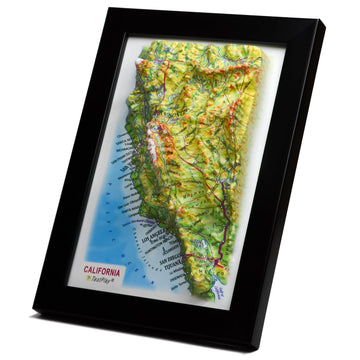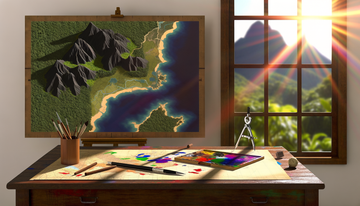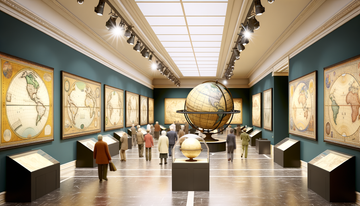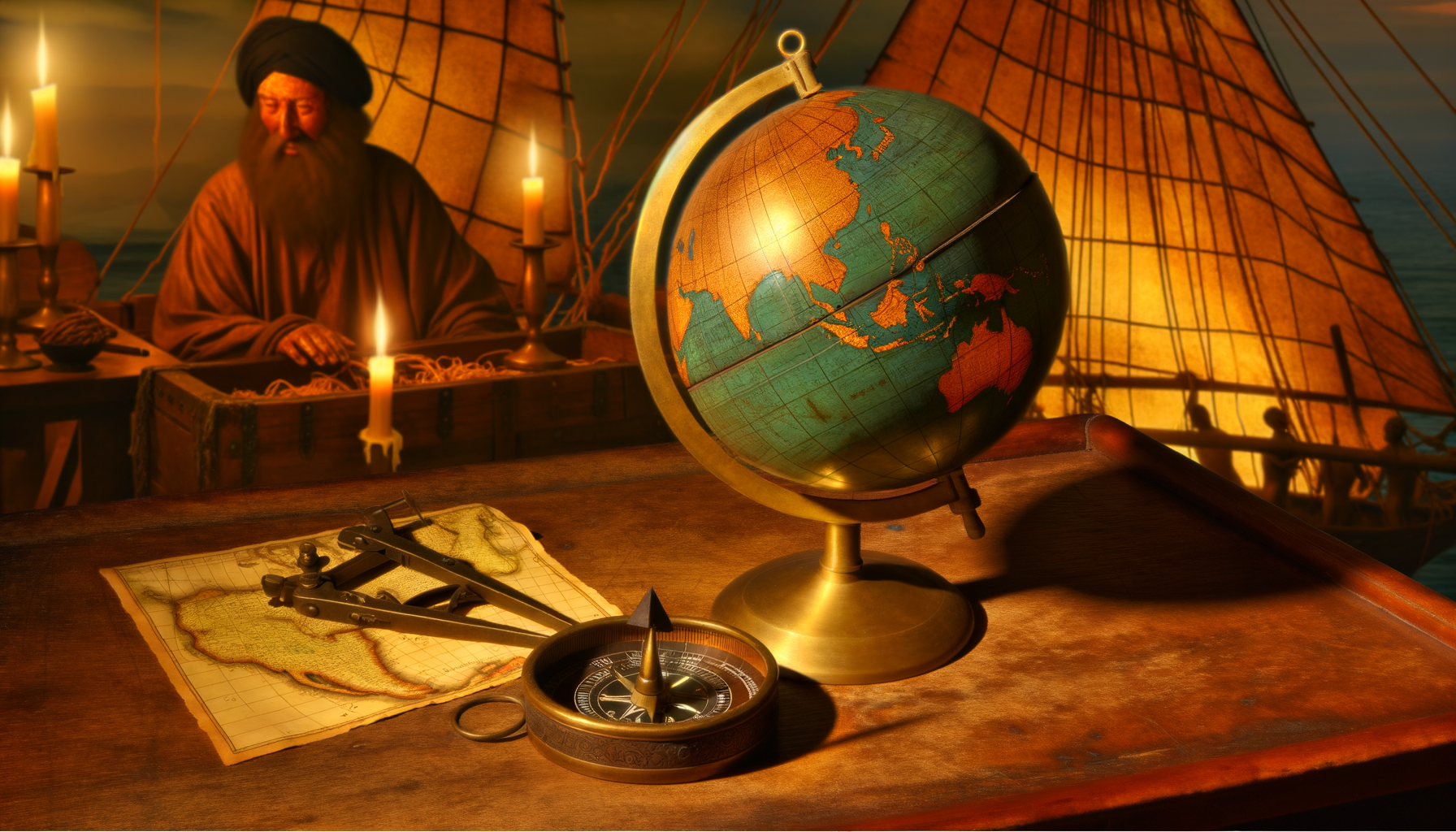Introduction: Navigating the Past Through Globes
Humanity's innate curiosity has always driven us to explore the unknown, pushing the boundaries of our understanding of the world. Navigation, the art and science of determining one's position and planning a route, has been fundamental to this enduring quest. While we often picture ancient mariners relying solely on stars, coastlines, or rudimentary maps, there was another sophisticated tool shaping geographical thought: the globe.
The idea of a spherical Earth was conceived and debated by ancient philosophers long before it became common knowledge, and with that idea came the revolutionary concept of representing this sphere as a miniature world. But were these early globes simply academic curiosities, or did they play a tangible role in the endeavors of ancient navigators and thinkers? This question is more complex than it might seem at first glance.
In this post, we will delve into the surprising and often overlooked role of globes in ancient navigation and geographical understanding. We will explore their philosophical origins, the earliest known examples and their construction, the crucial distinction between their theoretical and practical applications, the significant limitations they faced, and ultimately, their lasting legacy. By understanding how ancients conceptualized and used these spherical models, we gain deeper insight into their ingenuity and the foundations they laid for the global awareness we possess today. Consider this exploration your guide to uncovering the spherical insights of the ancient world, providing a clearer picture of how they literally and figuratively mapped their reality.
Early Concepts and Construction: Bringing the World to a Sphere
Before you can create a globe, you must first believe that the entity you are modeling is indeed a sphere. The concept of a spherical Earth was not initially intuitive; early cosmologies often depicted the world as flat, disk-shaped, or even a box. However, by the time of classical Greece, compelling philosophical and observational arguments for a spherical Earth began to take root and gain traction among intellectuals.
Thinkers like Pythagoras, in the 6th century BCE, are credited with some of the earliest notions of celestial bodies, including Earth, being spherical, based on aesthetic or mystical principles. Later, in the 4th century BCE, Aristotle provided empirical evidence for Earth's sphericity. He observed that the Earth's shadow on the moon during a lunar eclipse is always round, regardless of the moon's position, which can only happen if the Earth is a sphere. He also noted that as one travels north or south, certain stars appear or disappear over the horizon, another phenomenon consistent with a curved surface.
The practical implications of a spherical Earth were further explored by Eratosthenes of Cyrene in the 3rd century BCE. He famously calculated the Earth's circumference with remarkable accuracy by measuring the angle of the sun at two different locations (Syene and Alexandria) at the same time of day during the summer solstice. His work not only solidified the spherical model but also provided an initial estimate of its size, crucial information for anyone attempting to map or navigate across its surface. These intellectual leaps paved the way for the physical representation of the Earth as a sphere.
The Earliest Known Globes
With the idea of a spherical Earth firmly established in the intellectual sphere, the next logical step was to create a physical model. While we don't have surviving examples from the deepest ancient past, historical accounts describe the creation of early globes. The most famous early example attributed to depicting the Earth is the globe created by Crates of Mallus (or Mallis) in the 2nd century BCE. Crates was a Stoic philosopher and grammarian who headed the library at Pergamon. His globe was likely created as a model to illustrate his philosophical view of the world and its various zones.
Based on descriptions by ancient authors like Strabo, Crates' globe depicted the known inhabited world, the Oikoumene, as a single landmass. He theorized that there were three other large landmasses separated by vast oceans or impassable equatorial heat. These hypothetical continents were positioned in other quadrants of the sphere, creating a balanced, symmetrical model of the cosmos. While primarily a theoretical construct, Crates' globe represents a pivotal moment: the first known attempt to map the Earth as a complete sphere, even including significant hypothetical elements.
Other early examples were more likely celestial globes, representing the constellations and the apparent motion of the stars across the celestial sphere. The Farnese Atlas, a Roman copy of a Hellenistic sculpture from the 2nd century CE, depicts the titan Atlas holding a celestial globe showing constellations. While not a terrestrial globe, its existence demonstrates the ancient ability and desire to model spheres representing astronomical or geographical entities. The techniques and materials used for celestial globes would likely have been similar to those used for terrestrial ones.
Materials and Techniques
The construction of ancient globes, whether terrestrial or celestial, was a labor-intensive and skilled process, especially given the tools available at the time. The core of the globe was typically made from solid wood, often turned on a primitive lathe to achieve a spherical shape, or possibly built up using layers of material. For larger globes, a frame might have been used, covered with stretched animal hide or linen to create the spherical surface.
Once the sphere was prepared, it needed to be coated with a smooth surface suitable for drawing or applying maps. Plaster or gesso (a mixture of plaster and glue) was commonly used to create this smooth, opaque layer. The geographical or astronomical information would then be drawn onto this surface, either directly freehand based on existing maps and calculations, or perhaps transferred using methods we are not entirely certain of today.
Sometimes, parchment or papyrus sections with map details might have been applied to the surface before the final coating or painting. Pigments derived from minerals and plants were used to depict land, water, and other features. Achieving accuracy was incredibly challenging; transferring a flat map projection onto a curve distorts shapes and sizes, and ancient mapmakers were only beginning to grapple with these complex projection issues. Furthermore, the accuracy of the map itself was limited by the extent of actual exploration and measurement available at the time.
Theoretical vs. Practical Use: Globes as Tools and Symbols
One of the most debated aspects of ancient globes is the extent to which they were practical tools used in active navigation, particularly during voyages at sea. While the instinct might be to imagine a captain consulting a globe on the deck of their ship, the reality for the ancient period (roughly up to the late Roman era) is likely quite different. Ancient globes, especially the early ones, seem to have served more as sophisticated scientific models, educational aids, and visualization tools rather than handheld navigational instruments for everyday use on board a vessel.
It is crucial here to distinguish between terrestrial globes (representing the Earth) and celestial globes (representing the stars). Celestial globes were perhaps more directly linked to navigation, as understanding the position and movement of stars was vital for determining direction and latitude. Astronomers and navigators used celestial spheres or armillary spheres to model the heavens and predict celestial events, which informed their understanding of position finding. However, even these were often large, stationary instruments used for study and calculation on land or in relatively stable conditions.
Terrestrial Globes: Mapping the Known World
Terrestrial globes aimed to depict the Earth's surface as accurately as the available geographical knowledge allowed. They would show continents, oceans, major rivers, mountain ranges, and significant cities or landmarks. Crucially, they also provided a framework for understanding spatial relationships on a spherical surface. Unlike flat maps, which distort distances and angles, a globe accurately represents the relative positions and sizes of geographical features in a way that reflects the Earth's true shape.
Early globes would have likely depicted the known world (the Oikoumene) surrounded by hypothetical or unknown regions. They might have featured early forms of coordinate systems, such as lines of latitude (parallels) based on climatic zones or significant locations, and perhaps rudimentary lines of longitude (meridians) based on key observatories or reference points like the prime meridian used by Eratosthenes passing through Alexandria.
Key Geographical Information on Ancient Globes
Based on historical descriptions and what we know of ancient geography, the information likely found on early terrestrial globes would have included:
1. The Oikoumene: The inhabited world, primarily encompassing the Mediterranean basin, Europe, parts of Asia, and North Africa, with varying degrees of detail and accuracy depending on the region.
2. Major Landmasses and Oceans: Depictions of continents known at the time, the Mediterranean Sea, the Atlantic Ocean (often referred to as the Oceanus or Outer Sea), and possibly the Indian Ocean.
3. Significant Geographic Features: Major rivers (like the Nile, the Ganges), mountain ranges (like the Alps, the Himalayas), and large bodies of water.
4. Latitudinal Zones: Lines indicating different climatic zones or significant parallels of latitude based on astronomical observations, helping to understand the relationship between location and climate.
5. Key Cities or Locations: Important centers of civilization, ports, or reference points used in ancient geography.
However, the level of detail and accuracy would have been vastly different from modern globes, reflecting the limited extent of documented exploration and surveying. Large areas would have been speculative or left blank.
The Practical Application Debate
Were these terrestrial globes actually taken to sea and used by mariners for plotting courses or determining position during a voyage? The consensus among historians suggests this was highly unlikely for several compelling reasons. Ancient ships, even large ones, were subject to constant motion, pitching, and rolling, making it extremely difficult to use a stable, large globe for precise measurements or plotting. Globes of the necessary size to show useful detail would have been cumbersome, fragile, and easily damaged by the harsh marine environment (salt spray, humidity, physical shock).
Furthermore, direct position finding at sea relied more heavily on observing celestial bodies with instruments like astrolabes or quadrants (when they became available and refined), dead reckoning (estimating position based on speed, course, and time), and knowledge of prevailing winds and currents. Plotting a course was typically done on flat maps (portolans or similar charts) which, while distorting the overall picture, were far more practical for drawing lines, marking positions, and measuring distances in a usable format.
However, globes were almost certainly invaluable tools for *planning* voyages and for *teaching* geography and cosmology. In libraries, academies, or the homes of wealthy scholars, a globe provided a unique, intuitive way to visualize the spherical nature of the Earth. It allowed for the study of great circle routes (the shortest distance between two points on a sphere), even if plotting them precisely was challenging. It helped conceptualize distances across oceans and the relative positions of far-flung lands in a way that a flat map could not fully convey without significant mental effort.
Globes were also powerful teaching aids. They demonstrated the concept of latitude, longitude, and the Earth's rotation (as understood or theorized). They illustrated geographical relationships, helping students and scholars grasp the layout of the known world and speculate about the unknown. In this context, their role in advancing geographical understanding and informing the *planning* aspects of navigation was significant, even if they weren't handheld tools on deck.
Limitations and Challenges in Ancient Globe Use
Despite their revolutionary nature as models of a spherical Earth, ancient globes were fraught with significant limitations that constrained their accuracy and practical utility, particularly for detailed navigation. These challenges stemmed from both the state of geographical knowledge at the time and the technical difficulties inherent in their construction. Understanding these limitations is crucial to appreciating the context in which these early globes existed and were used.
Accuracy and Scale Issues
The most prominent limitation was the accuracy of the geographical information depicted. Ancient knowledge of the world was incomplete and often based on travelers' accounts, estimations, and sometimes pure speculation. Large areas of the Earth, particularly beyond the Mediterranean and parts of Asia, were unexplored or poorly mapped. This meant that any globe attempting to show the entire Earth had vast regions that were either blank, highly inaccurate, or filled with hypothetical landmasses and features, as seen in Crates' model.
Furthermore, even for known regions, precise surveying and mapping techniques were still developing. Accurate determination of longitude was particularly challenging for ancient geographers; it was often estimated based on travel time or perceived distances rather than astronomical calculations, leading to significant distortions in east-west positioning. Transferring existing flat maps onto a sphere also presented technical difficulties in maintaining accurate scale and relative proportions across the entire surface. The act of projecting a curved surface onto a flat one (for source maps) and then back onto a curved surface for the globe introduced unavoidable distortions unless handled with sophisticated mathematical methods that were nascent or non-existent in the earliest periods.
Portability and Durability
As discussed, the physical nature of ancient globes made them ill-suited for the rigors of ancient seafaring. To be useful for navigation planning or teaching, they needed to be large enough to display a reasonable level of detail. Larger size meant greater weight and fragility. Globes made of wood, plaster, and painted surfaces were susceptible to damage from moisture, impact, and abrasion. The constant motion of a ship would make precise measurements or viewing difficult and risked damaging the instrument.
Contrast this with the portability and relative durability of rolled maps, wax tablets for calculations, or even astronomical instruments like the astrolabe (once developed), which were designed or could be adapted for use in more challenging conditions. The simple fact is that the environment of an ancient ship was not conducive to the delicate nature and stationary requirement of a globe.
Availability and Cost
Creating a globe in the ancient world was an expensive and labor-intensive undertaking, requiring skilled craftsmanship and access to geographical knowledge. Consequently, globes were rare and valuable objects. They were not mass-produced tools available to the average mariner. Instead, they were typically owned by wealthy patrons, scholars, educational institutions (like the Library of Alexandria or the Lyceum in Athens), or perhaps rulers and courts interested in geography and cosmology.
This limited availability meant that their influence on navigation was primarily felt at the level of scholarship, planning, and theoretical understanding, rather than widespread practical use by sailors at sea. The direct tools used by most navigators were more accessible and suited to the immediate task of finding their way across shorter distances or along established routes. Globes represented the cutting edge of geographical visualization, a tool for those studying the world from a broader, more theoretical perspective.
Globes in the Broader Context of Ancient Navigation
To fully understand the role of ancient globes, we must place them within the broader ecosystem of ancient navigational practices and tools. Ancient mariners employed a variety of methods and instruments, each with its strengths and limitations. Globes did not replace these tools but rather complemented them, primarily in the realm of understanding and planning rather than execution at sea.
Compared to Other Navigational Tools
Flat maps, known as *periploi* (coastal sailing guides) or later, more structured geographical maps, were the most common visual aids for navigation planning and execution. Periploi were essentially detailed descriptions of coastlines, ports, distances, and landmarks, often accompanied by rudimentary drawings. More sophisticated maps, like those described by Ptolemy in the Roman era, attempted to use coordinate systems (latitude and longitude) on a flat projection. While flat maps suffer from distortion, they were practical for drawing routes, marking positions, and measuring distances along relatively straight lines or known coastlines. They were also easier to transport and handle at sea than globes.
Astronomical observations were fundamental to ancient navigation, particularly for determining direction at night using stars and estimating latitude based on the height of the sun or polar star. Instruments like the gnomon (a simple sundial for measuring angles) and later, early forms of the astrolabe or quadrant, allowed navigators and astronomers to make these crucial measurements. Celestial globes played a role here as models of the night sky, helping users understand the relationships between stars, constellations, and celestial poles, which was vital for celestial navigation theory and practice.
Dead reckoning, relying on estimating distance traveled based on speed and time, and maintaining a known course, was also a core technique. This required measuring speed (often estimated visually or with simple methods) and keeping track of time, sometimes using devices like water clocks. Experience and knowledge of currents, winds, and the appearance of the sea state were equally, if not more, important for day-to-day navigation than any instrument.
Compared to these tools, the terrestrial globe offered something unique: a faithful representation of the Earth's curvature. It allowed for a holistic view of the world, showing continents and oceans in their proper relative sizes and positions on a sphere. This was invaluable for long-range planning, understanding the feasibility of vast ocean voyages, and conceptualizing great circle routes that are not apparent on flat maps. While not a direct tool for steering a ship, it was a powerful tool for the geographic intellect that guided exploration.
Their Role in Advancing Geographical Knowledge
Perhaps the most significant role of ancient globes was their contribution to the advancement of geographical knowledge itself. By attempting to create a physical model of the spherical Earth, scholars were forced to confront the challenges of mapping, scale, and projection. The act of constructing a globe consolidated the known geographical information onto a single, coherent model, highlighting inconsistencies, gaps in knowledge, and the vastness of unexplored regions.
Globes made the abstract concept of a spherical Earth tangible and visual. They reinforced the idea that the world was a single, interconnected body, albeit with significant barriers like oceans and unknown lands. They provided a framework for integrating new geographical data as it became available from explorers, merchants, and soldiers. Errors on existing globes spurred efforts to refine measurements and gather more accurate information, contributing to the slow but steady progress of geographical understanding.
In essence, ancient globes were not just models of the world; they were tools for *thinking* about the world in a fundamentally new way. They were instruments of research and education that helped shape the geographical worldview of the intellectual elite, influencing how future voyages were conceived and how geographical data was organized and understood. They were a testament to the ancient Greeks' and Romans' ability to combine philosophical thought, mathematical calculation, and practical craftsmanship to represent complex scientific ideas.
Legacy and Connection to Modern Navigation
Although ancient globes may not have been common sights on the decks of triremes or Roman merchant ships, their conceptual importance cannot be overstated. They represented a profound shift in how humanity visualized its place in the cosmos and understood the structure of its own planet. The foundations laid by early philosophers and geographers in creating these spherical models have had a lasting impact on geography, cartography, and indeed, navigation, extending far beyond the ancient world.
How Ancient Globes Paved the Way
The most direct legacy of ancient globes is the enduring acceptance of the spherical Earth model. The intellectual arguments and physical representations provided by thinkers like Aristotle and Crates of Mallus helped solidify this concept over alternative flat-earth cosmologies among the learned. While the idea may have faded from prominence during certain periods or in different cultures, the precedent for depicting the Earth as a sphere was set.
Furthermore, the challenges faced in constructing ancient globes—particularly the issues of transferring 2D information to a 3D sphere and representing features accurately at scale—laid some of the earliest groundwork for the science of cartography. The very act of trying to map the Earth onto a globe highlighted the complexities of geographical representation and the need for systematic approaches to measurement and projection. While ancient solutions were rudimentary, they were initial steps towards the sophisticated mapping techniques developed in later centuries.
Ancient globes also established a powerful visual standard for global representation. They provided a tangible object that allowed people to literally see the entire known world (plus some speculation) in its true shape. This intuitive understanding of the Earth as a sphere has informed geographical education and exploration ever since. It facilitated the conceptual leap required for circumnavigation and long-distance transoceanic voyages, which became feasible in later periods with advancements in shipbuilding and navigation technology.
Globes Today: From Navigation to Education
Globes continue to be relevant today, albeit their primary role has shifted dramatically with the advent of advanced technology. Physical globes are still valuable educational tools, providing children and adults alike with an immediate, undistorted view of the Earth's continents, oceans, and geographical relationships. They are far superior to flat maps for understanding concepts like great circles, antipodes, and the relative sizes and positions of landmasses and bodies of water.
In terms of navigation, the physical globe on a ship's bridge is largely a relic, replaced by digital charts displayed on screens. However, the underlying principle—representing the Earth as a sphere for navigation purposes—is fundamental to modern global navigation systems. GPS (Global Positioning System) and other satellite navigation systems rely on precise calculations based on the Earth's shape, which is modeled as an oblate spheroid (a slightly flattened sphere). The coordinates provided by GPS receivers are spherical coordinates (latitude, longitude, and altitude).
Modern digital globes, such as Google Earth and other geographical information systems (GIS), are direct descendants of the ancient concept. They allow users to visualize the entire planet, zoom in on specific locations, and overlay various layers of data (topography, satellite imagery, population density, etc.). These digital tools are incredibly powerful for planning, analysis, education, and yes, modern forms of navigation and route planning, demonstrating a clear lineage back to the earliest attempts to model the Earth as a sphere. The ancient desire to see and understand the whole world on a sphere lives on in these sophisticated digital representations.
Conclusion: The Enduring Sphere of Understanding
The role of globes in ancient navigation is a nuanced story that challenges our modern assumptions about historical tools. While they were not the primary instruments used by sailors actively navigating the seas—a role better suited to maps, astronomical observations, and dead reckoning—ancient terrestrial globes held a crucial place in the development of geographical understanding and the *planning* aspects of exploration. They were sophisticated models that embodied the groundbreaking philosophical concept of a spherical Earth, long before this idea was universally accepted.
From the theoretical sphere of Crates of Mallus to the more detailed, though still limited, globes of the Roman era, these artifacts served as invaluable tools for scholars, educators, and anyone seeking to visualize the world in its true form. They helped to consolidate existing geographical knowledge, highlight the vastness of the unknown, and provided a framework for understanding the spatial relationships on a spherical surface in a way that flat maps could not replicate. Their limitations in terms of accuracy, portability, and cost meant they remained primarily in the hands of the elite and in academic settings.
Nevertheless, the legacy of ancient globes is profound. They were pioneers in representing the Earth as a whole, laying the conceptual foundation for cartography and global awareness. They reinforced the spherical model that is fundamental to all modern global navigation systems, from satellite GPS to digital mapping software. By exploring the history and purpose of these early spheres, we gain a deeper appreciation for the ingenuity of ancient thinkers and the iterative process by which humanity has come to map, understand, and navigate our spherical home. The ancient globe, though perhaps static and rare, was a dynamic force in shaping the way the world was perceived and ultimately explored.




